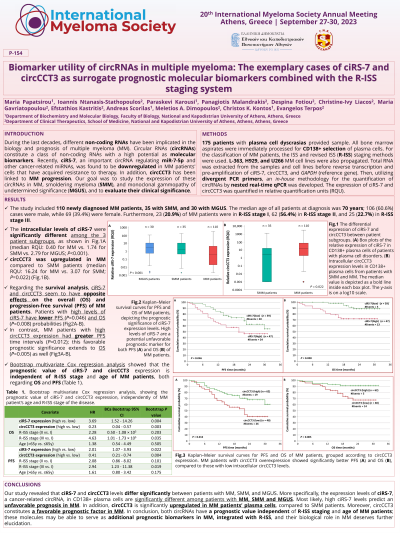Treatment of Newly Diagnosed Myeloma - Transplant Eligible
Poster Session 1
P-154: Biomarker utility of circRNAs in multiple myeloma: The exemplary cases of ciRS-7 and circCCT3 as surrogate prognostic molecular biomarkers combined with the R-ISS staging system
Wednesday, September 27, 2023
1:30 PM - 2:30 PM EEST


Maria Papatsirou, BSc (she/her/hers)
Scientific associate
National and Kapodistrian University of Athens
Athens, Attiki, Greece
Introduction: Circular RNAs (circRNAs) are a non-coding RNA type with potential as molecular biomarkers in multiple myeloma (MM). Recently, ciRS-7 was found to be downregulated in MM patients' cells that have acquired resistance to therapy, and circCCT3 has been linked to MM progression. Our goal was to study the expression of these circRNAs in MM, smoldering myeloma (SMM), and monoclonal gammopathy of undetermined significance (MGUS), and to evaluate their clinical significance.
Methods: 175 patients with plasma cell dyscrasias provided sample. All bone marrow aspirates were immediately processed for CD138+ selection of plasma cells. For the classification of MM patients, the ISS and revised ISS (R-ISS) staging methods were used. L-363, H929, and U266 MM cell lines were also propagated. Total RNA was extracted from the samples and cell lines before reverse transcription and pre-amplification of ciRS-7, circCCT3, and GAPDH (reference gene). Then, utilizing divergent PCR primers, an in-house methodology for the quantification of circRNAs by nested real-time qPCR was developed. The expression of ciRS-7 and circCCT3 was quantified in relative quantification units (RQU).
Results: The study included 110 newly diagnosed MM patients, 35 with SMM, and 30 with MGUS. The median age of all patients at diagnosis was 70 years; 106 (60.6%) cases were male, while 69 (39.4%) were female. Furthermore, 23 (20.9%) of MM patients were in R-ISS stage I, 62 (56.4%) in R-ISS stage II, and 25 (22.7%) in R-ISS stage III. The intracellular levels of ciRS-7 were significantly different among the 3 patient subgroups (median RQU: 0.40 for MM vs. 1.74 for SMM vs. 2.79for MGUS; P< 0.001), while circCCT3 was upregulated in MM compared to SMM patients (median value: 16.24 RQU in MM vs. 3.07 RQU in SMM; P=0.022). Regarding the survival analysis, ciRS-7 and circCCT3 seem to have opposite effects on the overall (OS) and progression-free survival (PFS) of MM patients. Patients with high levels of ciRS-7 have lower OS (P=0.008) and PFS (P=0.046) probabilities. In contrast, MM patients with high circCCT3 expression had greater OS time intervals (P=0.006); this favorable prognostic significance extends to PFS (P=0.015) as well. Bootstrap multivariate Cox regression analysis showed that the prognostic value of ciRS-7 and circCCT3 expression is independent of R-ISS stage and age of MM patients, both regarding OS (HR=3.69, BCa 95% CI=1.52-14.26, bootstrap P=0.004 for ciRS-7, HR=0.23, BCa 95% CI=0.043-0.57, bootstrap P=0.003 for circCCT3) and PFS (HR=2.01, BCa 95% CI=1.07-3.93, bootstrap P=0.022 for ciRS-7, HR=0.41, BCa 95% CI=0.21-0.74, bootstrap P=0.004 for circCCT3).
Conclusions: Our study revealed that ciRS-7 and circCCT3 levels differ significantly between patients with MM, SMM, and MGUS. Moreover, both circRNAs have a prognostic value independent of R-ISS staging and age of MM patients; these molecules may be able to serve as additional prognostic biomarkers in MM, integrated with R-ISS.
Methods: 175 patients with plasma cell dyscrasias provided sample. All bone marrow aspirates were immediately processed for CD138+ selection of plasma cells. For the classification of MM patients, the ISS and revised ISS (R-ISS) staging methods were used. L-363, H929, and U266 MM cell lines were also propagated. Total RNA was extracted from the samples and cell lines before reverse transcription and pre-amplification of ciRS-7, circCCT3, and GAPDH (reference gene). Then, utilizing divergent PCR primers, an in-house methodology for the quantification of circRNAs by nested real-time qPCR was developed. The expression of ciRS-7 and circCCT3 was quantified in relative quantification units (RQU).
Results: The study included 110 newly diagnosed MM patients, 35 with SMM, and 30 with MGUS. The median age of all patients at diagnosis was 70 years; 106 (60.6%) cases were male, while 69 (39.4%) were female. Furthermore, 23 (20.9%) of MM patients were in R-ISS stage I, 62 (56.4%) in R-ISS stage II, and 25 (22.7%) in R-ISS stage III. The intracellular levels of ciRS-7 were significantly different among the 3 patient subgroups (median RQU: 0.40 for MM vs. 1.74 for SMM vs. 2.79for MGUS; P< 0.001), while circCCT3 was upregulated in MM compared to SMM patients (median value: 16.24 RQU in MM vs. 3.07 RQU in SMM; P=0.022). Regarding the survival analysis, ciRS-7 and circCCT3 seem to have opposite effects on the overall (OS) and progression-free survival (PFS) of MM patients. Patients with high levels of ciRS-7 have lower OS (P=0.008) and PFS (P=0.046) probabilities. In contrast, MM patients with high circCCT3 expression had greater OS time intervals (P=0.006); this favorable prognostic significance extends to PFS (P=0.015) as well. Bootstrap multivariate Cox regression analysis showed that the prognostic value of ciRS-7 and circCCT3 expression is independent of R-ISS stage and age of MM patients, both regarding OS (HR=3.69, BCa 95% CI=1.52-14.26, bootstrap P=0.004 for ciRS-7, HR=0.23, BCa 95% CI=0.043-0.57, bootstrap P=0.003 for circCCT3) and PFS (HR=2.01, BCa 95% CI=1.07-3.93, bootstrap P=0.022 for ciRS-7, HR=0.41, BCa 95% CI=0.21-0.74, bootstrap P=0.004 for circCCT3).
Conclusions: Our study revealed that ciRS-7 and circCCT3 levels differ significantly between patients with MM, SMM, and MGUS. Moreover, both circRNAs have a prognostic value independent of R-ISS staging and age of MM patients; these molecules may be able to serve as additional prognostic biomarkers in MM, integrated with R-ISS.
